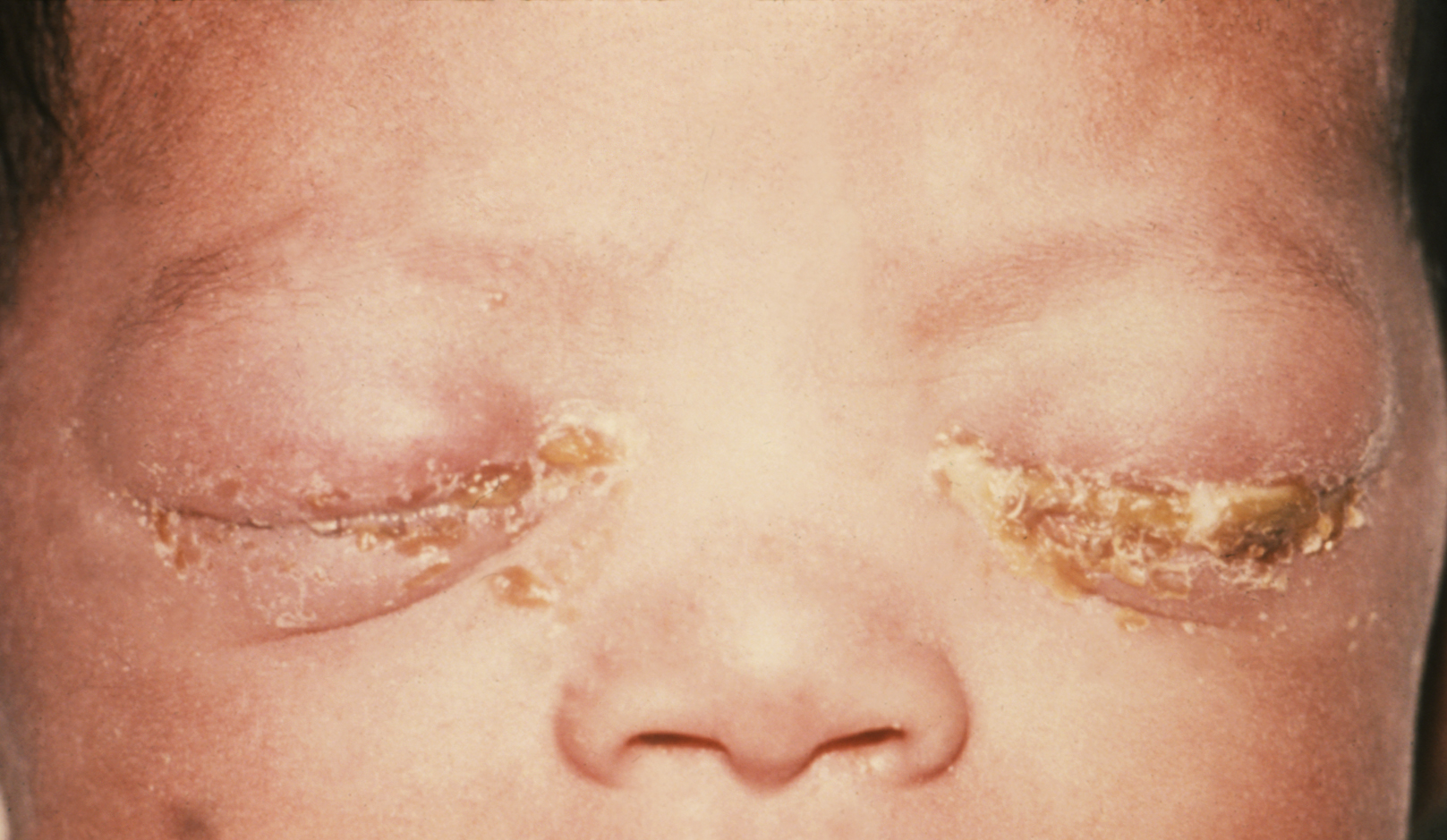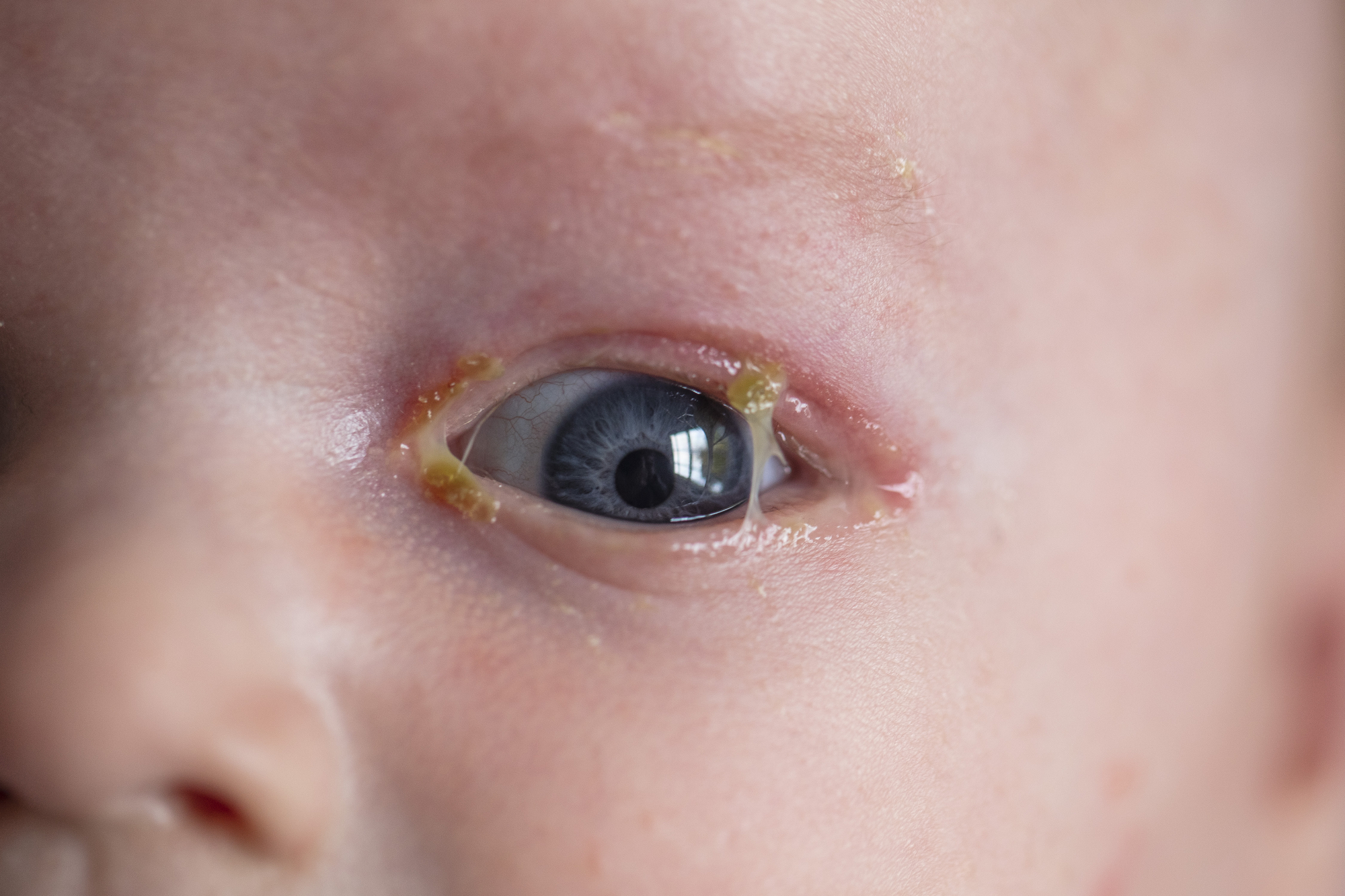Updated on June 20, 2025
Neonatal Conjunctivitis


Vision Center is funded by our readers. We may earn commissions if you purchase something via one of our links.
A newborn’s eyes are precious, and noticing anything wrong with them can be distressing for any parent. While some eye gunk may be harmless, neonatal conjunctivitis (ophthalmia neonatorum) needs immediate attention.
The good news is that timely action can prevent serious complications. Here's exactly what you should know and do if you notice signs of this condition in your baby.
What is Neonatal Conjunctivitis?
Neonatal conjunctivitis (ophthalmia neonatorum) is an infection that turns one or both of the eyes red. Conjunctivitis is more commonly known as “pink eye.”
The conjunctiva is the transparent layer of tissue surrounding the whites of the eye. When it gets inflamed or irritated, it turns pink or red.
Neonatal conjunctivitis occurs within the first 28 days of life (the neonatal period). It’s caused by a bacterial or viral pathogen acquired during birth, which may indicate that the birth canal is infected.
How Common is Neonatal Conjunctivitis?
Globally, neonatal conjunctivitis occurs in 1 to 12 percent of all newborns. However, its prevalence varies widely according to:
- Socio-economic conditions
- Health education
- Maternal healthcare
- Type of prophylaxis (preventative treatment) used
In developed countries, the rate of this condition is less than .5%, but it is much more common in low-income countries.
What Causes Neonatal Conjunctivitis?
Bacteria, viruses, and chemicals typically cause neonatal conjunctivitis. Historically, gonorrhea was considered the usual cause of neonatal conjunctivitis.
However, chlamydial infection is now more common. Common types of conjunctivitis include:
Bacterial Conjunctivitis
Bacterial conjunctivitis is the most common cause of ophthalmia neonatorum. This occurs when bacteria are transferred from the mother to the baby during birth.
The most common type of bacterial conjunctivitis is chlamydial conjunctivitis. Other bacteria that cause neonatal conjunctivitis include:
- Haemophilus species
- Streptococcus pneumoniae
- Staphylococcus aureus
- Staphylococcus epidermidis
- Streptococcus viridans
- Escherichia coli
- Pseudomonas aeruginosa
Gonococcal Conjunctivitis
Gonococcal conjunctivitis is the next most common bacterial conjunctivitis caused by Neisseria gonorrhoeae. Symptoms typically appear within 3-5 days after birth.
N. gonorrhoeae causes gonorrhea, a sexually transmitted infection (STI). Gonorrhea causes less than 1% of cases of neonatal conjunctivitis.
Chemical Conjunctivitis
Chemical conjunctivitis is caused by eye drops used to prevent gonococcal infection. They are commonly made of silver nitrate.
Fortunately, silver nitrate is no longer used in the United States. 0.5 % erythromycin ophthalmic ointment is now the standard prophylaxis.
Chemical conjunctivitis usually appears 6 to 8 hours after the eye drops are administered. It usually disappears spontaneously after 24 to 96 hours.
Adenoviral Conjunctivitis
Adenoviral conjunctivitis is caused by adenovirus. Adenoviral conjunctivitis is extremely contagious, and caregivers should use extreme caution and keep their hands clean to prevent the virus from spreading to others.
What Are the Symptoms of Neonatal Conjunctivitis?
The symptoms of neonatal conjunctivitis usually appear within the first day to two weeks after birth. Common symptoms include:
- Redness in the eye
- Mucopurulent or purulent discharge (liquid oozing from the eye)
- Chemosis, or swelling of the conjunctiva
- Symptoms may affect one or both eyes, often starting in one eye (especially with chlamydial infection) before spreading


Neonatal conjunctivitis might also be asymptomatic, so practicing good prevention is essential. If you think your child has neonatal conjunctivitis, talk to an ophthalmologist. They'll be able to rule out keratitis and other eye infections.
How is Neonatal Conjunctivitis Treated?
Common treatments for conjunctivitis in babies include:
- Frequent irrigation with sterile isotonic saline, lubrication, or artificial tears
- Avoiding eye patching
- Topical erythromycin
- Antibiotic drops or ointments
- Antivirals such as acyclovir
- Intravenous (IV) antibiotics such as ceftriaxone
- A warm compress to the eye
- Isolation of a patient to prevent contagion spread
Why Prompt Care Matters
While most cases of neonatal conjunctivitis are mild, some infections can rapidly get worse, especially when bacterial forms like gonorrhea or viruses like herpes cause it.
Without treatment, neonatal conjunctivitis can damage a baby’s vision permanently. Fortunately, with prompt medical care, nearly all complications are entirely preventable.
What Are the Potential Dangers of Neonatal Conjunctivitis?
The most common and dangerous complications relate to gonococcal conjunctivitis. These may include:
- Conjunctival scarring
- Keratitis
- Corneal pannus
- Permanent visual impairment
If left untreated, ophthalmia neonatorum can lead to severe complications, like corneal ulceration, corneal perforation, blindness, Pseudomonas infection, and pneumonia caused by chlamydia.
What is the Timeline of Neonatal Conjunctivitis?
Understanding when symptoms start is key to identifying the likely cause:
First Day
Within the first 24 hours after birth, you might see mild watery discharge and slight redness in both eyes. There may be some mild swelling, but the symptoms usually resolve within 24 to 48 hours.
It’s also not contagious at this stage. This may indicate chemical conjunctivitis, typically caused by prophylactic drops given at birth.
Days 2 to 5
Symptoms beginning at 2 to 5 days after birth may indicate gonococcal conjunctivitis, which is a medical emergency. Some signs to look out for include:
- Profuse yellow or green pus from one or both eyes.
- Significant eyelid swelling, which can cause the eyes to be swollen shut.
- Rapidly worsens within hours, even after cleaning.
This infection, caused by the bacterium Neisseria gonorrhoeae, can severely damage the cornea within days if not treated immediately.
One Week
Between days 5–14, discharge usually starts watery, becoming gradually thicker and more mucus-like. This slower-developing conjunctivitis is often caused by chlamydia.
Chlamydial conjunctivitis:
- Can start in one eye before affecting the other.
- May be accompanied by respiratory symptoms, such as cough or congestion, due to associated pneumonia.
- Requires oral antibiotics (often erythromycin) rather than just topical ointment.
Two Weeks
Symptoms arising within the first two weeks might indicate a viral infection, like Herpes Simplex Virus (HSV). It may also indicate a blocked tear duct.
Signs differentiating these causes include:
- Watery discharge, eyelid redness, skin blisters (vesicles), and possible fever or lethargy. This is serious and requires immediate antiviral treatment.
- A blocked tear duct that causes persistent watery or mucus discharge without redness or significant swelling. Often resolves naturally or with gentle massage.
- Usually mild watery discharge, possibly both eyes, with minimal discomfort.
Can You Prevent Neonatal Conjunctivitis?
All pregnant women should be screened for infections or sexually transmitted diseases (STDs) at their first prenatal visit. If they are infected, they should be treated before the baby is born.
State laws require most hospitals to use eye drops or ointment as ocular prophylaxis in a newborn's eyes.
They'll typically administer 0.5 % erythromycin ophthalmic ointment (the only agent routinely approved in the United States). In some jurisdictions, 1% tetracycline or 1% silver nitrate is an accepted alternative.
If you notice discharge or redness in your baby's eyes, don't wait. Contact your pediatric provider immediately or use VisionCenter's convenient "Find an Eye Doctor" tool.
In this article
7 sources cited
Updated on June 20, 2025
Updated on June 20, 2025
About Our Contributors
Alyssa is a content contributor and lead editor for Vision Center. She has a Master's degree in Journalism and over 6 years of professional experience writing expert-backed content in the health/medical space, including eye care and vision health. Her goal is to provide up-to-date information that is easy to understand, medically accurate, and engaging.
Dr. Melody Huang is an optometrist and freelance health writer with a passion for educating people about eye health. With her unique blend of clinical expertise and writing skills, Dr. Huang seeks to guide individuals towards healthier and happier lives. Her interests extend to Eastern medicine and integrative healthcare approaches. Outside of work, she enjoys exploring new skincare products, experimenting with food recipes, and spending time with her adopted cats.

